Tony's Home
| Clifford Math of
Consciousness at the Edge
of Chaos |
| Superposition Separation | Structures
| OrchOR | TimeScales
- Table - Graph |
| Cycles: Biology and Quantum |
| Conscious Universe |
Quantum Mind 2003 | QuanCon |
The Human Brain has about 10^18
Tubulins and 10^11 Neurons:
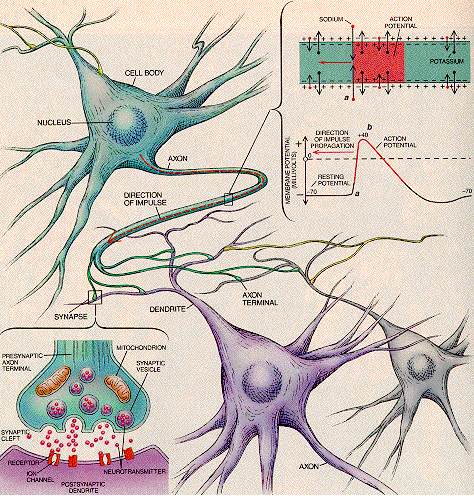
(image from Scientific American, September 1992,
article by Gerald D. Fischbach, Mind and Brain, page 52)
Neurons are on the scale of a micron (or 1,000
nanometers) in size. The micron size scale of a Neuron is in the
scale range at which the Casimir
effect is measurable and is also about the range of
GravitoEM Induction Region Virtual
Gravity Waves.
Submillimeter
gravity is being studied by experiments under way in 1998 at Stanford
and the University of Colorado in
Boulder.
Neurons are connected to each other by three types of
Communicating Junctions.
Electrons can cross the Gap Junctions by Quantum
Tunnelling, thus allowing Quantum
Superposition States to extend from Neuron to Neuron across
Gap Junctions.
Three types of Communicating Junctions are:
- Chemical Synapses, shown in detail above, have soccer-ball
shaped clathrins (made up of protein trimers called clathrin
triskelions) that control the release of neurotransmitter chemicals at
synapses. According to Evan Harris Walker
"... using values for the [Synaptic Junction] barrier ... (... the
energy of 0.07 eV [or 70 milli-electron-volts] (corresponding to the
bias potential across a neuron, or at the synaptic cleft) ...) ...
taken from neurophysiological data for the synapses, one can compute
the size of the synaptic cleft that would be necessary for electrons to
be able to tunnel across the cleft with a probability corresponding to
the probability for nominal central nervous system (CNS) synapses to
fire ... (... 0.3 to 3 milliseconds involved in typical synaptic firing
...) ... when an action potential arrives. The result of 180 Angstroms
[or 18 nanometers] corresponds exactly to what is found for CNS
synapses. ... This does not mean that the calcium ions play no role in
synaptic transmission, but it does say that that role is probably
secondary, and that the calcium hypothesis, taken alone, has turned out
to be less than satisfactory in explaining all experimental data ...".
- Electrical Synapses, or Ephases: According to Evan Harris Walker
"... Further, there is a class of synapses, called ephapses or
electrical synapses, that fire electrically rather than by chemical
release. These ephapses are morphologically identical to the synapses
in all respects except one: their clefts are about 150 Angstroms [or 15
nanometers] wide. Calculations show that reducing the thickness of the
cleft from 180 Angstroms to 150 Angstroms changes the electrical
behavior of the synapse in just the fashion found experimentally in
data that has been collected for these kinds of neurophysiological
structures. ...".
- Gap Junctions are direct
connections between cells, including not only Neurons and their
Dendrites, but also Glial Cells. Gap Junction structure is shown in
this image (from Figure 14-15 from Molecular Biology of
the Cell, 2nd ed, by Alberts, Bray, Lewis, Raff, Roberts, and Watson
(Garland 1989)):
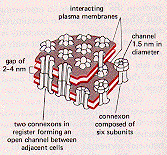
According to Stuart Hameroff,
"... A given cortical neuron may have 10,000 chemical synapses, and
relatively few gap junctions (15% of the number of chemical synapses
[or 1,500 Gap Junctions for a Neuron with 10,000 Chemical Synapses] is
sometimes estimated). ... There are special organelles (dendritic
lamellar bodies - DLBs) found only on either side of gap junctions in
dendrites in the brain. The DLBs are attached by filamentous proteins
to the microtubules, and their structure suggests they may be suitable
if not ideal for quantum electron
tunneling devices. ... What [Hameroff and Penrose have]
suggested is that electron tunneling occurs [across Gap Junctions]
between micotubules in each of two adjacent neurons. The distance
across the gap junction itself is only 3.5 nanometers, though its a bit
further to the [microtubules]. ...".
Cells
can
communicate by photons using centriole/microtubule
eyes.
The cytoskeleton of cells,
including neurons of the brain, is made up of microtubules:
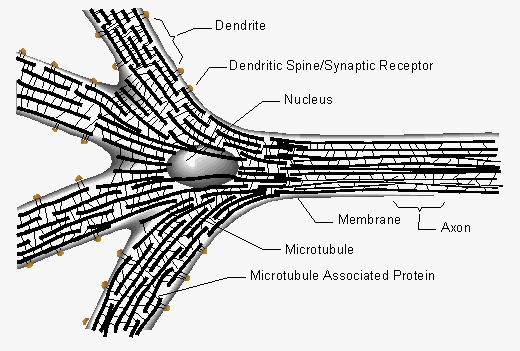
which are connected to each other by Microtubule Associated
Proteins (MAPs). With these structures in mind
Roger Penrose and Stuart
Hameroff propose that Consciousness involves a Planck scale
Decoherence of Quantum Superpositions that they call Orch
OR
in their
paper
entitled Orchestrated Objective Reduction of Quantum Coherence
in Brain Microtubules: The "Orch OR" Model for Consciousness.
Figure 1 (shown above) is a "Schematic of central region of neuron
(distal axon and dendrites not shown) showing parallel arrayed
microtubules interconnected by MAPs [Microtubule Associated
Proteins]. Microtubules in axons are lengthy and continuous,
whereas in dendrites they are interrupted and of mixed polarity.
Linking proteins connect microtubules to membrane proteins including
receptors on dendritic spines.".
Nanopoulos and his collaborators also
have a Microtubule-based quantum consciousness model.
The human brain contains about 10^18
tubulins.
Each microtubule is a
hollow cylindrical tube with about 25 nm outside diameter and 14 nm
inside diameter, made up of 13 columns of Tubulin Dimers.
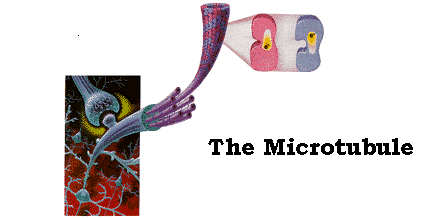
Click HERE for more details
about Microtubules.
Each Tubulin Dimer is about 8 nm x 4 nm x 4 nm, consists of two
parts, alpha-tubulin and beta-tubulin (each made up of about 450
Amino Acids, each of which contains roughly 20 Atoms), and can exist
in (at least) 2 different geometrical configurations, or
conformations, involving the position of a single Electron. Call this
Electron the Conformation Electron, because in a single Tubulin Dimer
its the position at the junction of the alpha-tubulin and the
beta-tubulin determines the 2 different conformations of the Tubulin,
which correspond to 2 different states of the dimer's electric
polarization.
At the 10-nanometer scale, the Casimir
effect produces the equivalent of 1 atmosphere of pressure
( according to a
September 2002 article by Astrid Lambrecht in Physics
World ).
An analogous structure is described in a 6
July 2001 New Scientist article by Willis Knight:
"... Molecular transistors that run on single electrons
now work at room temperature. Dutch scientists achieved the feat by
buckling carbon nanotubes with an atomic force microscope. ... "The
next step will be to think about how to combine these elements into
complex circuits," ... lead researcher Cees Dekker of Delft University
... says. Molecular computers would be high speed and low power. ...
The transistors inside normal computers control the flow of thousands
of electrons at a time. Transistors capable of manipulating individual
electrons could potentially do the same work faster and more
efficiently. However, functioning at this tiny scale can be difficult
as heat can cause electrons to leak in and out of the molecular
components. To avoid this, previous molecular transistors were cooled
to near absolute zero. The Delft researchers wanted to create a device
that worked at more practical temperatures. By buckling a metallic
carbon nanotube, they formed a small area from which a single electron
cannot escape at room temperature unless a current is applied via an
electrode. ... An interesting and unexpected quantum phenomena also
came from the experiment. Dekker says that pushing a single
electron through the transistor caused it to exhibit quantum coherence. This means
that the electron maintains some of the quantum state it obtained
whilst inside the transistor when it leaves. The effect is not found
within normal electronics. ...".
According to Physics
News Update Number 603 #2, September 9, 2002 by Phil Schewe, James
Riordon, and Ben Stein:
"... certain highly curved (on a nanoscopic scale) surfaces
modify the electromagnetic properties of physical
vacuum in their vicinity. This changes the behavior of an atom near
nanobodies (quantum dots, nanospheres, nanocylinders, etc.). Generally
called the Purcell effect, the phenomenon happens because an excited
electron inside the outside atom strongly senses the modified structure
of physical vacuum near surfaces in its vicinity. New calculations
performed by physicists at the Belarusian State University in Minsk
show that due to unique conducting properties of carbon nanotubes
the fluorescence rate of an excited atom or molecule in their vicinity
should be enhanced by as much as million, a much greater effect
than for other geometries studied. The Purcell effect has been observed
in many of these other cases, and the Belarusian scientists (contact
Prof. Sergei Maksimenko, maksim@bsu.by) hope to find collaborators to
test their nanotube hypothesis. The hope is to exploit the enhanced spontaneous decay rate
to control the behavior of nuclei, atoms, or organic molecules outside
or inside nanotubes. (Bondarev et al.,
Physical Review Letters, 9 September 2002.) ...".
The Tubulins in a Microtubule
can represent Information, and act as
Cellular Automata to
process it.
The human brain contains about 10^11 neurons. There are 10^7
Tubulin Dimers per neuron, with 10% of them, or 10^6, estimated to be
involved in the consciousness process, and the remainder doing other
things needed to keep the cell alive.
The equivalence of Gravitation
of
the massless spin-2 Gravitons of MacroSpace and the
Gravitation of our physical SpaceTime, justifies the Superposition
Separation idea of Penrose and Hameroff:
As discussed in my paper for
Quantum Mind 2003, Raymond
Chiao's proposed gravity antenna experiments might give experimental
support for gravity-resonance among the tubulin
electrons.
Roger Penrose says, in Shadows of the Mind (Oxford 1994),
page 344, "... We can now consider the gravitational
self-energy of that mass distribution which is the difference
between the mass distributions of the two states that are to be
considered in quantum linear superposition. The reciprocal of
this self-energy gives ... the reduction timescale ...".
This is the decoherence time T = h / E.
For a given Particle, Stuart Hameroff describes this as a
particle being separated from itself, saying that the Superposition
Separation a is "... the separation/displacement of a mass
separated from its superposed self. ... The picture is spacetime
geometry separating from itself,
and re-anealing after time T. ...".
In the Osaka paper ( Hameroff, S.R. (1997) Quantum
computing in microtubules: an intra-neural correlate of
consciousness? Cognitive Studies: Bulletin of the Japanese Cognitive
Science Society 4(3):67-92.) ), Hameroff says that Penrose
describes Superposition Separation as "... shearing off into
separate, multiple spacetime universes as described in the Everett
"multi&endash;worlds" view of quantum theory. ...".
Jack Sarfatti
proposes that a Quantum Fluctuation in a State of Superposition is
not Reduced until the Gravitational Binding Energy of the
Difference among the Superposed States exceeds the Bekenstein
threshold of One Bit of Shannon Classical
Information, that is, the product of Energy E and Time T
equals Planck's Constant h, giving the decoherence time formula T = h
/ E.
According to an
article in
the New
Scientist vol 173 issue 2333 - 09 March
2002, page 27, e-mailed to me by Gary S. Bekkum: "... Penrose
suggests that whenever a particle is in a superposition of states,
then space-time must also be in a superposition. "You have two
separate distortions of space-time," he says. But the particle would
have slightly different amounts of gravitational energy, with respect
to the objects around it, in each of these two states. ... This ...
creates an "uncertainty" in the energy. ... if you want to allow a
large uncertainty in a system's energy, then that energy uncertainty
can only exist for a very short time. ... the energy uncertainty
between two superposed states means that all superpositions are
inherently unstable and limited to a certain lifetime. The bigger the
object in superposition, the more energy difference between the
individual states that make up the superposition, and thus the bigger
its energy uncertainty. And the bigger the uncertainty, the faster it
decays into one state or the other. Penrose estimates that for an
object the size and mass of a proton, a superposition of states can
last for millions of years. Atoms and molecules would not last as
long in superposition, but still far too long for the collapse to be
measured. ... But long before an object contains enough atoms to span
the thickness of a cat's whisker, its large gravitational energy
prevents a superposition from lasting longer than a millionth of a
second. And so gravity explains why ... you've never found yourself
in two states or places at once-and neither would Schrödinger's
cat. Penrose calls this process "objective state reduction" ...
Penrose has enlisted the help of Dik Bouwmeester and William Marshall
at Oxford's Centre for Quantum Computation (CQC). ... Bouwmeester and
Marshall plan to put a microscopic crystal, less than a micrometre
across and containing about 10^15 atoms, into a superposition of
being in two different places at once. Tiny though this crystal
is, by quantum standards it is huge-well within the realm of the
macroscopic world. Penrose estimates the crystal's mass will force
any superposition to decay within 1/100th to 1/10th of a second.
That's slow enough to measure the change, and fast enough to
distinguish the result from standard quantum mechanics, which decrees
the superposition should last indefinitely. The experiment will begin
with a laser firing a photon at a beam splitter, which sends the
photon along two paths at once in classic quantum fashion. Along one
path the photon heads towards a mirror, which reflects it back to the
beam splitter. On the other path, the photon hits a crystal suspended
on a carbon filament in such a way that it will recoil slightly when
hit by the photon. The superposition of the two photon paths forces
the crystal into its own superposition of two locations at once: one
where it has recoiled and the other where it remained stationary
because the photon took the other path. After bouncing off the face
of the crystal, the photon then heads towards a second mirror. This
portion of the photon's flight is timed precisely so that the photon
is reflected back to arrive at the crystal at the very moment this
has returned to its original position. The crystal then reflects the
photon back to the beam splitter, where it recombines with its
parallel state as if they had never been apart. "If quantum mechanics
with all of its superpositions remains true, then it will always go
back out the way it came," says Penrose. In this case, everything
about the original photon is preserved. It passes through the beam
splitter the way it came, and goes straight back into the laser. The
photon detector placed in the alternate path from the beam splitter
will detect nothing. If the detector does register nothing every time
the experiment is run, it will confirm that each photon is indeed
"aware" of both paths. But the researchers will arrange the
experiment so that the photon's flight through the apparatus takes
more than one-tenth of a second. In this case, Penrose says the
crystal's superposition should decay while the photon is still in the
apparatus. That means the two possible paths will have reverted to
one, and the photon's superposition will also have to decay. In this
scenario, the photon comes to the beam splitter having been forced to
choose one path or another. At the beam splitter it might be sent
back into the laser, but half of the time it will be reflected
another way and end up in the waiting detector. As elegant as it
looks on paper, the experiment contains a formidable array of
technical challenges. Everything will have to be arranged to ensure
that the two parallel states of the photon are undisturbed by the
world outside the experiment. But there are many ways to upset things
and bring about decoherence, such as thermal energy jiggling the
atoms in the crystal. The key to the experiment will be minimising
such thermal noise and then seeing if the results change when
parameters such as the size of the crystal are varied slightly. The
challenge in designing the experiment is compounded by the fact that
only an X-ray photon has enough punch to give the crystal the
required kick, and X-rays are notoriously difficult to reflect. And
the fact that the photon must be in flight for at least 1/10th of a
second means the experiment has to take place over distances on a par
with the diameter of the Earth. One solution to this problem will be
to place the experiment in space, on two co-orbiting platforms. In
deference to Schrödinger and his cat, Penrose has contrived to
call this arrangement of his experiment the Free-orbit Experiment
with Laser-Interferometry X-rays, or FELIX. ...". Also see
quant-ph/0210001
byWilliam Marshall, Christoph Simon, Roger Penrose, Dik Bouwmeester,
who say: "... We propose a scheme for creating quantum
superposition states involving of order 10^14 atoms via the
interaction of a single photon with a tiny mirror. ...the question
... whether unconventional decoherence processes such as
gravitationally induced decoherence or spontaneous
wave-function collapse occur. ...
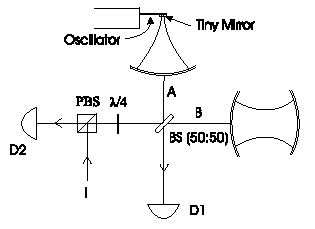
.... the experiment ... consists of a Michelson
interferometer in which one arm has a tiny moveable mirror. The
radiation pressure of a single photon displaces the tiny mirror. The
initial superposition of the photon being in either arm causes the
system to evolve into a superposition of states corresponding to two
distinct locations of the mirror. In the present proposal a
high-finesse cavity is used to enhance the interaction between the
photon and the mirror. The observed interference of the photon allows
one to study the creation of coherent superposition states periodic
with the motion of the mirror. ... If the environment of the mirror
"remembers" that the mirror has moved, then, even after a full
period, the photon will still be entangled with the mirror's
environment, and thus the interference for the photon will be
reduced. Therefore the setup can be used to measure the decoherence
of the mirror. ...".
If the Superposition consists of States
involving one Particle of Mass m, but with Superposition Separation
a, then the Superposition Separation Energy Difference is the
gravitational energy
E = G m^2 / a
An essential ingredient in this model is the
gravitational interaction between the two different position states of
tubulin electrons. Although the position separation between the two
states of any single given tubulin electron is about a = 1 nanometer =
10^(-7) cm, which is well within the micron range of strong gravity,
what is relevant is the total gravitational interaction among all N
tubulin electrons, and the vast majority of them within the 10-cm
scale human brain are far more distant from each other than the micron range of strong gravity,
so in calculating the superposition energy E_N of N tubulin electrons
and the corresponding time T_N, you should use (as do Hameroff and
Penrose) ordinary Far Field gravity with ordinary G.
Since the human brain is on the order of 10 cm, its volume is
about 10^3 cm^3. Since a micron is 10^(-6) m = 10^(-4) cm, and since
the human brain has about 10^18 tubulin electrons, it has about 10^18 /
10^3 = 10^15 tubulin electrons/cm^3, so that the typical linear
distance between tubulin electrons is about 1 / (10^15)^(1/3) = 1 /
10^5 = 10^(-5) cm = 0.1 microns. Therefore the micron range of strong
gravity is far enough to connect a tubulin electron with its near
neighbors (near including nearest neighbors plus up to order 10 near
neighbors). These overlapping Near Field Induction/Static region
gravitational neighborhoods help the human brain to maintain
superposition of its 10^18 tubulin electrons.
In other words, ordinary weak gravity determines E_N and T_N for
the human brain as a whole, while micron-range strong
Induction/Static Region gravity with overlapping
micron-range neighborhoods helps
maintain the superpositions during the T_N time of a conscious
thought.
Therefore (ignoring for
simplicity some factors like 2 and pi, etc.):
T = h / ( G m^2 / a ) = ( h / m c ) ( c^2 / G m ) ( a / c ) =
( Compton / Schwarzschild ) ( a / c )
where
2 G m / c^2 = Schwarzschild Radius of a classical black hole of
mass m and
h / m c = Compton Radius of the Sidharth Kerr-Newman naked
singularity model of an elementary particle of mass m.
Consider the case of one free
Electron and Ordinary Gravity:
Here, ordinary gravity is used, not because it is realistic for a
1-naonometer distance, but because the calculation for a single
Electron will be used as the basis for a superpositon of N Electrons
over the 10-cm scale human brain, for which ordinary gravity is
realistic and should be used. If the single Conformation Electron
with mass m_e has a Superposition Displacement a that is of the order
of 10^(-7) cm, or one nanometer, then, since Compton = 10^(-11) cm
and Schwarzschild = 10^(-55) cm and the speed of light c = 3 x 10^10
cm/sec, and since E_electron = G ( m_e )^2 / a, we have
for a single Electron and ordinary gravity
T_electron = h / E_electron =
= ( Compton / Schwarzschild ) ( a / c ) = 10^26 sec = 10^19
years.
Now consider the case of N Tubulin Electrons in Coherent
Superposition, in which ordinary gravity is
realistic.
As Jack Sarfatti says, "Since all the [Conformation]
Electrons are nonlocally connected into a coherent whole we do
not want to treat them as fluctuating statistically independent of
each other ... .", and Stuart Hameroff agrees, saying "True. That's
why we consider them coherently linked or entangled.". As Jack
Sarfatti explains, "... this is for a macro-mass M. So change m to
M = Nm for a network of N connected pieces forming a coherent
whole. Note the pair binding energy is small. But we need the
gravity self-energy of this big whole of N entangled pieces since
this is some kind of a quantum collective mode! Therefore, the size
parameter ... is the whole not the part. We are not looking at the
gravity self energy of the part, but the gravity self energy of the
whole. Since it also has to be a metric fluctuation, I use Wheeler's
"L" for the scale of the metric fluctuation.So, I get ...[ E =
G M^2 / L = N^2 G m^2 / L where ]... L is the scale of the
metric quantum gravity fluctuation in the sense of John Archibald
Wheeler. Clearly L is over the entire region of cortex containing N
switching units that coherently participates in the "orch OR" process
whatever it may be. So how do we relate L to the microdisplacements
of the pieces of the whole? The obvious thing to try is L^3 = N
a^3 [where] "a" is the displacement of each piece. Now
you can use Hameroff's pictures of what the individual pieces are
doing to get a number for "a". Remember we are only doing orders of
magnitude so we are not interested in 1% or even 10% corrections. If
we get roughly the right power of 10 we are happy. ... the entire
model is still very primitive. ...
Ansatz:
( c Gravity Self-Collapse Time )^2 (
Classical )^2 = ( Quantum )^2 ( Spatial Coherence Length )^2 = 4D
Blister Volume
for quantum gravity self-collapse from
[Hameroff-Penrose] space-time geometry separation.
( c T )^2 ( G M / c^2 )^2 = ( h / M c )^2 L^2
That is
( c Coherence Time )( Classical Wormhole
Radius ) = ( Quantum Wormhole Radius ) ( Spatial Coherence Length )
c T G M / c^2 = ( h / M c ) L
G M^2 / L = h / T
L = a N^(1/3)
M = N m
a = spatial coherence length of a single q-bit
m = mass of a single q-bit
N q-bits form a single coherent network or
collective mode. So
( c Collective Coherence Time ) / (Collective
Mode Coherence Length ) = ( Quantum / Classical )
The effective squared space-time interval is ( c
Coherence Time ) - ( Spatial Coherence Length ). When is this zero or
lightlike? Clearly only when Quantum = Classical [at the Planck scale
of] M = 10^(-5) gm. For elementary particles (Quantum/Classical)
>> 1, so the effective interval is timelike. For classical black
holes the reverse is true so the effective interval is spacelike. ...
Note the squares of the lengths are all Bekenstein information
measures! So timelike means that in some sense the Bekenstein temporal
information is greater than the spatial information since each bit of
Bekenstein information has area h G / c^2 [which is the square 10^(-66)
cm^2 of the Planck length, which can be compared to the square 10^(-22) cm^2 of the Electron Compton Radius]. So we see that the square of the space-time interval in
Einstein's classical theory of relativity has a deeper informational
meaning. The hyperbolic signature of spacetime means subtracting two
informational measures. In Hawking's imaginary time we add the
measures. This also connects with the Christodoulo black hole fusion
formula that obeys the Pythagorean theorem ... . Both relativity and
quantum theory are really surface forms of an information theory
according to Wheeler's "IT FROM BIT". ... In first order perturbation
theory in the space-time picture (not the momentum-energy space) use
Huyghen's principle for the quantum information waves of the coherent
spatially separated q-bit sources
(Gm^2/L)^(1/2) ( e^(i PHI(j+)) + e^(i
PHI(j-)) ) / 2
is the Wheeler-Feynman quantum gravity near field
Huyghen's wavelet from the jth q-bit, where j = 1 to N, + is the
advanced phase and - is the retarded phase from the two poles of the
Feynman propagators. Note the coherent absorbers in the nano-boxes
protecting the q-bits from environmental decoherence allow for the
Libet-Radin-Bierman back-causation from non cancellation of the
advanced against the retarded amplitudes! That is the interference
between past and future is no longer completely constructive in
sentient matter. The total coherent Feynman amplitude is
( G m^2 / L )^(1/2) Pribram Brain Hologram
Phase Modulation Pattern
This Phase Modulation Pattern is the coherent sum
of the both the advanced (from the future) and the retarded (from the
past) phase factors. All alternative histories have equal amplitude
hence the common (Gm^2/L)^1/2 factor. In the "ground state" all the
phases are zero and we get for the squared coherent amplitude
N^2 G m^2 / L = N^(5/3) G m^2 / a
where T = h / ( N^(5/3) G m^2 / a ) for the
objective decay of the Bohm information field in the implicate order.
(... in ... ordinary matter where the individual phases are random ...
you would get N G m^2 / a for incoherence of individual pieces instead
of N^2 G m^2 / L for the coherent mesoscopic collective mode ...) In
addition, there is the self-organization time from the self-reaction of
the Bohm world line to the action of the Bohm information field on that
world line t = Tgrw / N ...".
Jack Sarfatti defines the Superposition Energy E_N of N superposed
Conformation Electrons in N Tubulins as
E_N = G M^2 / L
where L is the mesoscopic quantum phase coherence length for the
collective mode of N Conformation Electrons of total mass M in the N
Tubulins, so that
E_N = N^2 G m^2 / a N^(1/3) =
= N^(5/3) G m^2 / a=
= N^(5/3) E_electron
To get the decoherence time for the system of N Tubulin Electrons,
recall that T_electron = h / E_electron = (
Compton / Schwarzschild ) ( a / c ) = 10^26 sec = 10^19 years, so
that
T_N = h / E_N = h / N^(5/3) E_electron =
= N^(-5/3) T_electron =
= N^(-5/3) 10^26 sec
and (ignoring for simplicity
some factors like 2 and pi, or 4 in this case)
N = (10^26 / (T_N) )^(3/5) =
= 10^15 / (T_N)^(3/5)
From the above formulas get the following rough approximate
Table of Decoherence Times T_N for various phenomena and structures
involving various Numbers of Tubulin Dimers or Neurons, assuming that
10% of the Tubulins in each Neuron are involved in the process of
consciousness:
Time Number of Number of Scale L =
T_N Tubulins Neurons = N^(1/3) s
10^(-43) sec (Planck) 10^41 10^35 500 km
10^(-14) sec (local protein) 2 x 10^23 2 x 10^17 50 cm
10^(-10) sec (global protein) 10^21 10^15 10 cm
10^(-10) sec (Frohlich) 10^21 10^15 10 cm
10^(-5) sec 10^18 10^12 1 cm
5 x 10^(-4) sec (2 kHz) 10^17 10^11 0.5 cm
25 x 10^(-3) sec (40 Hz) 10^16 10^10 0.2 cm
100 x 10^(-3) sec (EEG alpha) 4 x 10^15 4 x 10^9 0.16 cm
500 x 10^(-3) sec (Radin/Bierman) 1.5 x 10^15 1.5 x 10^9 0.11 cm
1 sec 10^15 10^9 0.1 cm
10^10 sec = 300 years 10^9 10^3 10^(-3) cm
10^15 sec = 3 x 10^7 years 10^6 1 10^(-4) cm
10^26 sec = 3 x 10^18 years 1 10^(-6) cm
(In the above table, the scale factor s is
taken to be about 10 nanometers, which is roughly the scale of each
Tubulin Cage, which is roughly 10 times the scale a of the
Displacement Distance of each Tubulin Electron.)
- The 10^11 Neuron line of the table
corresponds to the number of neurons in the human brain.
- The 10^16 Tubulin line of the table
coorresponds to 40 Hz brain activity with
7,500 km wavelength and high Schumann Resonances.
- The 4 x 10^15 Tubulin line of the table
corresponds to the 0.1 second GRW
time limit of conscious phenomena, in the sense that shorter-term
phenomena operate on a sub-conscious level, with (as Ira Einhorn notes,
citing the Penrose footnote on page 374 of Shadows of the Mind) the
possibility that short-term high frequency sub-conscious phenomena
might be connected to "... the more familiar brain wave activity (such
as the 8-12 Hz alpha-rhythm). ... such lower frequencies might arise as
beat frequencies ...". It also
corresponds to the scale of 0.16 cm, or a volume of about 1/200 cm^3,
with respect to which Jack Sarfatti says (here I have substituted some
of my numerical values for his):
- "... Note the volume ... is the sum of the volumes of all [5
x 10^15 Tubulins] even though they are separated in physical space from
each other over the whole cortex of volume 10^3 cc - they are like one
super-particle entangled in configuration space of [about 3 x 5 x 10^15
dimensions]! That is, this sentient post-quantum computing "enchanted
web" is [5 x 10^15 little Tubulin nanoboxes] ... . Each box has a
little arrow in Hilbert space and all the arrows are phase-locked over
a time of order 0.1 sec. The actual physical distance between the boxes
is irrelevant to this Einstein-Podolsky-Rosen network that is one
coherent conscious system. The mesoscopic quantum coherence length L is
what you would get if you lined up all these nanoboxes in a row - about
[ 1/6 ] cm. It is really not a metrical property in ordinary space. ..."
- The 1.5 x 10^15 Tubulin line of the table corresponds to 0.5 seconds, roughly
consistent with the Radin/Bierman
stimulus-experience time. Consider a Hamiltonian Circuit of 1.5 x
10^15 Tubulins in a Quantum Consciousness superposition, with each
Tubulin being about 100 nanometers from a near neighbor. If gravitons
moving at the speed of light traverse such a Hamiltonian circuit, then
the time for a traverse of the Quantum Consciousness Hamiltonian
Circuit is 1.5 x10^15 x 100 nm / c = 1.5 x (10^15 x 10^(-5)) cm /
c = 1.5 x 10^10 cm / c = 0.5 sec, which is also the T_N time
for 1.5 x 10^15 Tubulins.
If N (number of Tubulins) is more than 1.5 x 10^15
(at 100 nm distance), then the time of traverse of a Quantum
Consciousness Hamiltonian Circuit is greater than T_N, so there is not
enough time to form a complete Hamiltonian Circuit, and the Quantum
Consciousness Superposition will contain more than one Circuit.,
and none of them will be a complete Hamiltonian Circuit. If
N is less than 1.5 x 10^15 (at 100 nm distance) there is time for the
Quantum Consciousness Hamiltonian Circuit to be orbited more than once.
These ideas arose from e-mail discussions with Jack Sarfatti and Daniel
Lapadatu.
The Hamiltonian Circuit problem is NP-complete, but the
brain's Quantum Consciousness acts as a Quantum
Computer and tries all Many-Worlds
possibilities at once, thus finding an optimal Hamiltonian Circuit very
quickly.
- The 10^6 Tubulin line of the table
corresponds to the micron size of the Electron GravitoEM Induction Region.
Sidharth-Sarfatti Electron Gravito EM
Induction Region Virtual Gravitons (range about a micron, and
corresponding period (10^(-15) sec) of submillimeter gravity, which is
being studied by experiments under way in 1998 at Stanford and the
University of Colorado in Boulder.
Other possibly relevant phenomena are:
the van der Waals interaction; and
Sidharth-Sarfatti Proton GravitoEM
Induction Region Virtual Gravitons that have nanometer-scale
range, similar to the scale of Tubulins, of the Superposition
Separation Distance of the Conformation Electron of a Tubulin, and of
gap junctions.
To see that this picture is consistent with the
electron picture, start with the case of one Tubulin
whose Conformation Electron is in Coherent Superposition with the
Atoms of the Tubulin. Since the Tubulin has 2 parts (alpha and beta),
each with about 450 amino acids, and each amino acid has about 20
Atoms, the Tubulin consist of about 2x450x20 = 18,000 Atoms, or about
20,000 Atoms. I consider that the entire Tubulin is only displaced by
a distance a_tubulin such that the total Superposition Separation
Energy of the entire Tubulin is equal to the Superposition Separation
Energy of its Conformation Electron by a nanometer. Hameroff
and Penrose, in Section 5.1.1 (Protein Spheres) of their Orch OR
paper, have calculated the Superposition
Separation Energy, saying (changing some of their notation): "...
Since the [Superposition Separation] displacement is less
than the sphere radius, we need a detailed calculation to obtain the
gravitational self-energy E of the difference between the displaced
mass distributions for each tubulin monomer, considered as a uniform
sphere. Taking the sphere to have a radius R and the distance of
displacement to be a, we find, as the result of a double
integration:
E = m^2 G (a^2 / 2 R^3 - 3 a^3 / 16 R^4 + a^5
/ 160 R^6) ...".
If the radius R of the Tubulin is taken to be
about 2 nanometers as a rough estimate, and the displacement will be
much less than R, then, as Hameroff and Penrose say, "... We can
ignore the higher-order terms, so we obtain ...
E = m^2 a^2 / 2 R^3 ...".
If there are about 5 nucleons per Atom, and about
20,000 Atoms per Tubulin, then there are about 100,000 nucleons per
Tubulin. Since the mass of a nucleon is about 2,000 Electron masses,
the total mass of the Tubulin is about 2 x 10^8 m_e, where m_e is the
Electron mass. If E_e is the Superposition Separation Energy of one
Electron by one nanometer and the Tubulin is to be displaced by a
distance a so that the Superposition Separation Energy E_tubulin of
the Tubulin is equal to E_e, we have (ignoring some factors of 2 for
simplicity):
E_tubulin = E_e = G (m_e)^2 / (1 nanometer )
= (G (2 x 10^8 m_e)^2 a_tubulin^2 / 2 (2 nanometer)^3
)
so that the Superposition Separation for the
entire single Tubulin is given by
a_tubulin^2 = 4 x 10^(-16) nanometer ^2 = 4 x
10^(-30) cm^2
a_tubulin = 2 x 10^(-15) cm
and
T_tubulin = h / E_tubulin = h / E_electron =
T_electron =
= 10^26 sec = 10^19 years.
Since 10^(-13) cm = 5 GeV^(-1), a_tubulin = 2 x
10(-15) cm = (1/50) x 10^(-13) cm corresponds to an energy scale of
about 250 GeV, which is roughly the Higgs
Vaccum Expectation Value (possibly related
to the Compressibility
of
the Aether), and is of the order of the
masses of the Truth
Quark and Weak
Force interactions involving W and Z gauge
bosons, and probably of the (not yet
experimentally observed) Higgs
Scalar, all of whose masses are of the
order of 100 GeV, or about 200,000 m_e.
Jack Sarfatti has noted the relevance of the fundamental
which sets a threshold for consciousness phenomena at Tgrw_N =
Tgrw / N, since GRW Dynamical Decoherence scales as 1 / N. I use the
value Tgrw = 3 x 10^14 sec. You can find the intersection point of
the Tgrw_N function with the T_N Tubulin Back-Reaction function by
setting
T_N = (1 / 10 ) T_electron / N^(5/3) = 10^25 / N^(5/3) = Tgrw
/ N
so that the number of Tubulins N_BRgrw at the intersection point
is
N_BRgrw = ( 10^25 )^(3/2) Tgrw ^(-3/2) = ( 10^25 )^(3/2) ( 3
x 10^14 )^(-3/2) =
= ( 3 x 10^10 )^(3/2) = 5 x 10^15 Tubulins.
From the above table, N_BRgrw Tubulins
roughly corresponds to:
- 0.1 seconds, so that shorter-term phenomena must operate on a
sub-conscious level;
- EEG alpha waves, about 4 x 10^9 Neurons (or about 4 percent of
the 10^11 Neurons in a human brain); and
- a part of the brain about 1/6 of a centimeter in size.
How are GRW and
Tubulin Back-Reaction related?
The GRW event at Tgrw_N means that Superposition is
Destroyed because of GRW, which is an
Individual Process for each Tubulin Site Electron, and not by
an Orch OR Orchestration of a Superposition of States of many Tubulin
Site Electrons.
The Tubulin event at T_N means that Superposition is
Destroyed, not by an Individual GRW Process, but as the Climax
of an Orch OR Orchestration of a Superposition of Tubulin States
that produces a Superposition (or, from the Penrose point of view, a
blister of superposition of spacetimes) that grows so large that it
decoheres because it is so big that it violates the uncertainty
principle E T = h and thus cannot hold together coherently.
A Superposition of an Orch OR Orchestration Process in
progress will be Terminated Without Completion if the
GRW event occurs before the Tubulin event of the Orch OR process,
or, in other words, if Tgrw_N is less than T_N where N is the number
of Tubulins involved in the Orch OR process.
To see more clearly how this works, make the following logT - log
N plot of the Tgrw_N GRW function versus the T_N Orch OR Tubulin
Back-Reaction function:
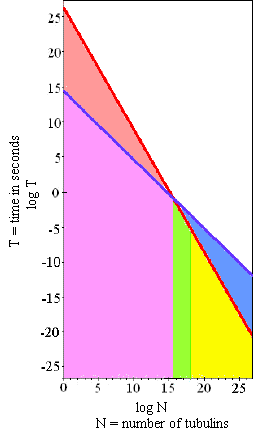
In the above logT - logN curves::
- the red line is for Orch OR Tubulin
Back-Reaction, T N^(5/3) = 10^26;
- the blue line is for GRW, T N = 3 x
10^14;
- the red area is OK for coherent
superposition for Orch OR Tubulin Back-Reaction, but not for GRW;
- the blue area is OK for coherent
superposition for GRW, but not for Orch OR Tubulin Back-Reaction;
- the purple, green,
and gold areas are OK for coherent
superposition for GRW and Orch OR Tubulin Back-Reaction.
Therefore, taking into account both GRW and Orch OR Tubulin
Back-Reaction, the purple,
green, and
gold areas are the only regions for
coherent Superposition of States. The
purple area is the area of Small Scale
Abstract Thought Consciousness due to GRW Superposition of States,
while the green and
gold areas are the areas for Large Scale
Abstract Thought Consciousness.
For N smaller than the intersection of the curves, that is, for N
smaller than about 5 x 10^15, which is the
purple area, the GRW curve controls,
because GRW decoherence occurs before Orch OR Tubulin
Back-Reaction decoherence has time to occur. Since for GRW T N =
constant, that is a curve that is equivalent to the Hameroff T = h /
E curve.
For N larger than the intersection of the curves, which is the
green and
gold areas, the Tubulin Back-Reaction T
N^(5/3) = constant curve that Jack Sarfatti formulated is the one
that controls, because Orch OR Tubulin Back-Reaction decoherence
occurs before GRW decoherence has time to occur.
The green area is the part of the
Orch OR Tubulin Back-Reaction region for which N is at most 10^18, or
in other words, for which N is within the size of the human
brain at 10^7 Tubulins per Neuron.
The gold area is the part of the Orch
OR Tubulin Back-Reaction region for which N exceeds about 10^18, or,
at 10^7 Tubulins per Neuron, for which N exceeds the size of the
human brain.
Therefore, to make decisions faster, or, in other words, to
decohere the coherent superpostion faster, you need more and more
Neurons. The fastest that humans can think is the upper limit of
the green region, on the order of about 10^(-5) seconds.
Further, for less than about 10^15 Tubulins or so, GRW
decoheres the superposition BEFORE the Orch OR Tubulin Back-Reaction
decoherence takes place, so that you must have AT LEAST 10^15
Tubulins to have Large Scale Abstract Thought consciousness based on
Orch OR Tubulin Back-Reaction. Since 10^15 Tubulins is about 10^9
Neurons or so (assuming that 10 per cent of the 10^7 Tubulins in a
Neuron are available for conscious thought rather than doing other
things to maintain the cell), a brain 1 per cent the the size (10^11
Neurons) of a human brain is large enough to be Conscious with
respect to Large Scale Abstract Thought by the Orch OR Tubulin
Back-Action mechanism (of course, other
mechanisms
could be responsible for different forms of what is
sometimes called consciousness, including but not limited to Small
Scale Abstract Thought by GRW Superposition of States and simple
Neural Network learning).
There should also be an upper limit on the scale of a Tubulin
brain, at which the time for light to travel the scale
distance is greater than the Orch OR Tubulin Back-Reaction
decoherence time. From my table, it seems that is a little
over 10^21 Tubulins, for which the scale is about 10 cm, the
light travel time is 10 / (3 x 10^10) = 3 x 10^(-10) sec and the
Tubulin Back-Reaction decoherence time is 10^(-10) sec.
However, if you want the Orch OR Tubulin Back-Reaction
decoherence phenomena to be synchronized with chemical phenomena
such as neurotransmitter transfer, then you cannot use the speed
of light, and must use a much slower speed and so
insist that the minimum timescale be of the order of a fraction of
a millisecond at the shortest. For half a millisecond, the
number of Tubulins is 10^17, and (assuming that 10 per cent of
the 10^7 Tubulins in a Neuron are available for Abstract Thought
Consciousness rather than doing other things to maintain the cell)
the maximum number of Neurons
is about 10^11, the size of the human brain.
Abstract Thought Consciousness is the process of operation by
an Abstract Thought on a Superposition of Many Abstract
Ideas.
Large Scale Abstract Thought Consciousness is due to Orchestrated
Coherence of many Electrons, such as by the Hameroff-Penrose Orch OR
process.
Small Scale Abstract Thought Consciousness is due to GRW
Superposition of States, and involves single Elementary Particles
or Coherent (generally smaller) Groups of Elementary Particles.
If the GRW process is considered to be an expression of the Mind
of the Universe, then the GRW termination may allow
small-N things to be more
tuned in to the Mind of the Universe at large, while
large-N things would be more
self-absorbed by the self-contained orchestration process.
The crossing point where Tgrw =
T_N is roughly at the size of the Human Brain, and is also
roughly where N is such that it is equally in touch with
the Mind of the Universe
(through GRW) and
the self-conscious self
(through the self-contained orchestration process).
Since submillimeter
gravity of Sidharth-Sarfatti Electron
GravitoEM Induction Region physics has a range of only about a
micron, which is about the size of a single Neuron,
How can the Superposition of Quantum Consciousness States
extend beyond the range of a single Neuron to encompass States
involving many Neurons located in widely separated parts of the
Cortex?
Consider Two Types of Cycle:
The Biology Cycle:
The Biology Cycle is based on Stuart Hameroff's viewpoint,
and is very similar to it. Its Stages are:
1 - A Tubulin Site Electron
sits within its tubulin cage in one of its 2 Quantum States. The
Tubulin Site Electron has one of 2^1 = 2 States, so it contains
one qbit of information, representable by the
2^1 = 2-dimensional Cl(1) Clifford
Algebra that is isomorphic to the Complex Numbers.
2 - That Tubulin acts on its Microtubule
through the Tiling (and possibly through interaction with Superradiant Photons in the
Microtubule Core). The sum of such actions by N_mt Tubulins within
the Microtubule determines the Conformation State of the Microtubule.
The Conformation State is representable by the 2^N_mt dimensional
Cl(N_mt) Clifford Algebra.
3 - The Microtubule Conformation State
is transmitted by MAP links to affect the
Conformation States of other Microtubles in the same Neuron.
4 - The size of the main body of a Neuron is
roughly the micron range of submillimeter
gravity. To connect between different Neurons, Stuart Hameroff has
"... suggested ... that Electron [Quantum]
Tunneling [such as that described by Evan Harris Walker]
occurs between Micotubules in ... adjacent Neurons. The
distance across the Gap Junction itself
is only 3.5 nanometers, though it is a bit further to the Microtubules.
... There are special organelles (dendritic lamellar bodies - DLBs)
found only on either side of Gap Junctions in dendrites in the brain.
The DLBs are attached by filamentous proteins to the Microtubules,
and their structure suggests they may be suitable ... for Quantum
Electron Tunneling devices ...".
5 - Through
the links of Stages 2-4, a total of N Tubulin Site Electrons are
connected and brought into a coherent Superposition of States. The
Superposition of States is representable by the 2^N dimensional Cl(N) Clifford Algebra.
The QUANTUM STATE CYCLE occurs during the
Superposition of States. It is based on Penrose lightcone cycles
and on Sarfatti Back-Reaction. Many
of the Quantum States of the Superposition are Closed Timelike Loops,
some of which intersect with others. If each Closed Timelike Loop
represents an Abstract Idea, then the Intersections among the
Closed Timelike Loops represent Interactive Abstract Thought
operating on the set of Abstract Ideas.
During the time of Superposition, new Abstract Thoughts
can be derived from the original ones by reorganizing the
corresponding Closed Timelike Loops and their Intersections.
This Thought Process of forming and holding an Abstract
Conscious Thought, does not involve a physical flow of a current of
Electrons across the Synaptic Junction, but rather involves
maintaining a coherent state that extends to both sides of the Synaptic
Junction, thus connecting the two Neurons.
Dimi Chakalov has made an important observation about the Quantum
State Cycle: "... Talking about what is going on "during" Superposition
is like trying to explain how a completely dark room might look like,
by showing pictures of it. ...". Even though the Quantum State Cycle is
not easy to observe, it is the process of Abstract Conscious Thought.
6 - The Quantum State
Cycle ends when the Decoherence/Collapse time T_N is reached.
Then, Decoherence/Collapse occurs, and a single Abstract Idea is chosen
from the enlarged Set of States in the Superposition.
This is the Execution Process, which involves choosing one
Abstract Idea and rejecting/executing the other Ideas of the
Superposition.
If T_grw is shorter than T_N, then
Decoherence/Collapse occurs by GRW instead of by the OR reduction in
the Orchestated Objective Reduction Orch OR process of
Penrose-Hameroff, whose Decoherence/Collapse time is T_N. Since GRW
Decoherence/Collapse is due to the collapse of any individual one
of the N Tubulin Site Electrons in the Superposition, and T_N
Decoherence/Collapse is due to the Orchestrated Decoherence/Collapse of
all N of them acting together coherently, GRW Decoherence/Collapse
destroys the process of Abstract Conscious Thought, so that Abstract Conscious thought does not exist for N less
than about 5 x 10^15 Tubulin Site Electrons.
7 - When you Execute the Thought by
choosing an Abstract Idea State, the chosen State from the
Superposition determines the Positions of all the Gap Junction
Electrons of the Quantum Tunnelling connections between
Neurons.
8 - The Positions of the Gap Junction
Electrons determine the Conformations of the Micrtubules
that are adjacent to the Gap Junctions.
9 - The Conformations of those Microtubles
determine, through MAP connections, the Conformations of
other Microtubules in the same Neuron.
10 - The Conformation of a Microtubule
determines the State of its Tubulins.
11 - The State of a Tubulin
determines the State of its Tubulin Site Electron, thus COMPLETING THE BIOLOGY CYCLE.
Each single Biology Cycle contains ONE Quantum
Superposition of States.
Each Quantum Superposition of
States contains MANY Closed
Timelike
Loops of Bohm-Sarfatti Back-Reaction. Each of the
Closed Timelike Loops represents an Abstract Idea, and their
Superposition represents an Abstract Thought that operates on and
with those Abstract Ideas.
In the Hameroff-Penrose model, Roger Penrose describes the Closed
Timelike Loops in terms of Lightcones of Relativity. Penrose
describes a quantum gravity theory of David Deutsch in which only a
very small fraction of the spacetime geometries in a superposition
contain closed timelike loops. Even the very small fraction of closed
timelike loops permit non-computable operations to be performed by a
human-brain quantum computer, which could feed on its own output,
running around the closed timelike loop.
Within the range of about a micron, Sidharth-Sarfatti
GravitoEM Induction Region physics gives submillimeter
gravity. In the D4-D5-E6-E7 physics
model, virtual 4-pair gravitons,
which are effectively Planck-mass black holes, could tilt the
lightcones of spacetime, resulting in closed timelike loops. For an
illustration of tilted lightcones, see the lightcones in Duchamp's
The Large Glass. In the D4-D5-E6-E7 physics model, such tilted
lightcone spacetimes may be only a very small proportion of any
quantum superposition describing physical spacetime.
In The
Transactional Interpretation of Quantum Mechanics due to Cramer, Rev.
Mod. Phys. 58 (1986) 647-687), the probability of taking a given
link in a path among the Many Worlds is the product of amplitude for
that link times the amplitude for its complex conjugate. Since the
complex conjugate amplitude is the time reversal of the link
amplitude, Cramer's picture is that of the present interacting with
the future. The present amplitude makes an "offer" that can be
accepted by a "handshake" with a complex conjugate amplitude
"confirmation" from the future, so that the resulting observation is
a "transaction". The offer from the past is Yang,
while
the confirmation from the future is like Yin.
Combined,
they form Closed Timelike Loops.
Therefore,
the Mind might be able to influence Fate
by selecting which of the Many-Worlds
in the AllSpaces will experience in the
Future.
In this connection, it is interesting to note that
In addition to the Human Brain Biology Cycle described above,
there are:
Similar GRW Cycles involving
single Elementary Particles and Coherent Groups of Elementary
Particles, but generally involving fewer Particles and
therefore producing Small Scale Abstract Thought Consciousness, as
opposed to the Large Scale Abstract Thought Consciousness of
Hameroff-Penrose Orch OR Biology Cycle.
Other possible types of Biology Cycles based on Biologies
different from that of the Human Brain.
Dimitri Nanopoulos and his collaborators have written a series of
papers describing a model of quantum consciousness that is similar to
mine in that it involves microtubules, but differs in that it is
based on superstring theory. In hep-th/9207103,
John Ellis, N.E. Mavromatos and D.V. Nanopoulos say:
"... We argue that the light particles in string theory
obey an effective quantum mechanics modified by the inclusion of a
quantum-gravitational friction term, induced by unavoidable couplings
to unobserved massive string states in the space-time foam. This term
is related to the W-symmetries that couple light particles to massive
solitonic string states in black hole backgrounds, and has a formal
similarity to simple models of environmental quantum friction. It
increases apparent entropy, and may induce the wave functions of
macroscopic systems to collapse. ... the evolution of
quantum-mechanical systems over time-scales that are long compared with
the Planck time should be described by a modified Liouville equation
...[that]... is characteristic of open quantum-mechanical systems, and
represents in our interpretation the intrinsic coupling of a
microscopic system to space-time foam. ... An operationally similar
modification of the Liouville equation was proposed independently on
completely phenomenological grounds by Ghirardi,
Rimini and Weber [GRW], and the required values of their model
parameters were entirely consistent with our upper bounds and
order-of-magnitude estimates. ...".
In hep-ph/9505374,
Nanopoulos
says:
"... MicroTubules (MTs), protein polymers constructing the
cytoskeleton, participate in ... bioinformation processes such as
learning and memory, by possessing a well-known binary error-correcting
code with 64 words. In fact, MTs and DNA/RNA are unique cell structures
that possess a code system. It seems that the MTs' code system is
strongly related to a kind of "Mental Code" in the following sense. The
MTs' periodic paracrystalline structure make them able to support a
superposition of coherent quantum states, as it has been recently
conjectured by Hameroff and Penrose, representing an external or mental
order, for suffcient time needed for effcient quantum computing. Then
the quantum superposition collapses spontaneously/dynamically through a
new, string-derived mechanism for collapse proposed recently by Ellis,
Mavromatos, and myself. ... At the moment of collapse, organized
quantum exocytosis occurs, i.e., the simultaneous emission of
neurotransmitter molecules by the synaptic vesicles, embedded in the
"firing zone" of the presynaptic vesicular grids. Since in the
superposition of the quantum states only those participate that are
related to the "initial signal", when collapse occurs, it only enhances
the probability for "firing" of the relevant neurotransmitter
molecules. That is how a "mental order" may be translated into a
"physiological action". Our equation for quantum collapse, tailored to
the MT system, predicts that it takes 10,000 neurons O(1 sec) to
dynamically collapse, in other words to process and imprint
information. Different observations/experiments and various schools of
thought are in agreement with the above numbers concerning "conscious
events". If indeed MTs, with their fine structure, vulnerable to our
quantum collapse mechanism may be considered as the microsites of
consciousness, then several, unexplained (at least to my knowledge) by
traditional neuroscience, properties of consciousness/awareness, get
easily explained, including "backward masking", "referal backwards in
time", etc. Furthermore, it is amusing to notice that the famous puzzle
of why the left (right) part of the brain coordinates the right (left)
part of the body, i.e., the signals travel maximal distance, is easily
explained in our picture. In order to have timely quantum collapse we
need to excite as much relevant material as possible, thus signals have
to travel the maximal possible distance. The non-locality in the
cerebral cortex of neurons related to particular missions, and the
related unitary sense of self as well as non-deterministic free will
are consequences of the basic principles of quantum mechanics, in sharp
contrast to the "sticks and balls" classical approach of conventional
neural networks. The proposed approach clearly belongs to the
reductionist school since quantum physics is an integrated part of our
physical world. ... the quantum collapse becomes a detailed dynamical
mechanism instead of being an "external" ad-hoc process, may find some
application to some quantum aspects of brain function. It looks like a
big universality principle is at work here, because both in the black
hole and the brain we are struggling with the way information is
processed imprinted, and retrieved. ...".
In quant-ph/0007088,
Andreas
Mershin, Dimitri V. Nanopoulos and Efthimios M.C. Skoulakis
say:
"... We identify quantum-physics derived mechanisms
conceivably underlying the integrated yet differentiated aspects of
memory encoding/recall as well as the molecular basis of the engram. We
treat the tubulin molecule as the fundamental computation unit (qubit)
in a quantum-computational network that consists of microtubules (MTs),
networks of MTs and ultimately entire neurons and neural networks. ...
in our model, a single neuron is upgraded from a relatively simple (yet
adjustable) switch to a device capable of information processing. In
addition, within the context of our model, (at least some) neurons are
capable of launching fast connections to establish correlations with
distant neurons using the principles of quantum entanglement and/or
photon interactions ... The tubulin system described above could easily
serve as a textbook example of how a biological qubit should look like!
The two tubulin conformations make for a simple binary qubit with the
ability of entanglement with similar neighboring qubits/dimers in the
protofilaments giving us a quantum cluster! The timescale for the
spontaneous conformational changes in the tubulin dimers is of order 10
11sec Once in an entangled state, a "measurement" or interaction with
the environment will collapse the state into one of its basis states
... Yet, the correlations can be communicated instantaneously among the
tubulin qubits ... spanning entire MTs or conceivably whole neurons or
neural networks. ...
... Damage to neural MTs resulting from hyperphosphorylation of
... a microtubule associated protein (MAP), results in memory loss in
Alzheimer's Disease (AD) patients ... Neurofibrillary Tangles (NFTs)
are bundles of twisted MTs that are no longer held apart by their MAPs.
Post-mortem histological examination of AD patients shows a clear and
direct correlation between NFTs and duration and severity of the
disease ...
... binding of an anesthetic molecule to the hydrophobic pocket of
the tubulin dimer may have the effect of preventing changing the
electron orbitals (i.e. the tubulin's ability to flip) thus shutting
the whole system down. ... Furthermore, if the general anesthetic
concentrations are not too high, complete reversibility of anesthetic
effects is possible, indicating that the temporary van der Waals
blockage of the crucial tubulin electron(s) has ended and
conformational changes are free to occur again. ...
... There is evidence that the hollow interior of MTs may be
capable of supporting a very special state of "ordered" water molecules
both inside and outside of the MT ... The interaction of the
dipole-quanta coherent modes with the protein dimers results in an
entanglement which we claim is responsible for the emergence of soliton
quantum coherent states, extending over large scales, e.g. the MT or
even the entire MT network. ...
... the existence of a quantum-error correcting code is needed to
protect the delicate coherent qubits from decoherence. This has been
the major problem of quantum computers until the works of Shor and
Steane have independently shown that such a code can be implemented. We
conjecture that the K-code apparent in the packing of the tubulin
dimers and protofilaments is partially responsible for keeping
coherence among the tubulin dimers. By simulating the brain as a
quantum computer it seems we are capable of obtaining a more accurate
picture than if we simulate the brain as a classical, digital computer.
...
... We have been successful in our initial experiments to train
flies and test their learning and memory for up to 6hrs. ... However,
our initial attempts to localize MAP-2 within the fly brain have been
unsuccessful. ... We are currently in the process of trying a number of
anti-MAP-2 polyclonal antibodies to select the one that best reveals
the MAP-2 distribution in the fly brain. ...".
In quant-ph/0204021,
Nick
E. Mavromatos, Andreas Mershin, and Dimitri V. Nanopoulos
say:
"... We refine a QED-cavity model of microtubules (MTs) ...
and suggest mechanisms for the formation of biomolecular mesoscopic
coherent and/or entangled quantum states, which may avoid decoherence
for times comparable to biological characteristic times. This refined
model predicts dissipationless energy transfer along such "shielded"
macromolecules at near room temperatures as well as quantum
teleportation of states across MTs and perhaps neurons. ...
microtubules (MTs) can be treated as quantum-mechanically isolated
(QED) cavities, exhibiting properties analogous to those of
electromagnetic cavities routinely used in quantum optics. Recently,
our speculative model has been supported by some indirect experimental
evidence. It has been experimentally shown, that it is possible to
maintain partial entanglement of the bulk spin of a macroscopic
quantity of Caesium (Cs) atoms (N = 10^12), at room temperature, for a
relatively long time (0.5ms). ... In such experiments entanglement is
generated via interaction with pules of light. ... A direct consequence
of our model for MTs as QED cavities is that virtually every
experimentally known QED-cavity-based observation may have an analogue
in living MTs and we show this analytically with the specific case of
intra- and inter-cellular dissipation-less energy transfer and quantum
teleportation of coherent quantum states. ... we present a straight
forward calculation of how quantum teleportation of states can occur in
MTs, in direct analogy to the suggester experimental quantum
teleportation in optical cavities that has been observed recently. We
also draw a parallel between certain geometrical features of MTs such
as their ordered structure which obeys a potentially
information-encoding code and suggest how this can be exploited for
(quantum) error-correction and dense coding. ... teleportation of
coherent quantum states across and between cells ...[is defined]... the
complete transfer of the coherent state of an MT without any direct
transfer of mass or energy. This means that the 'receiver' MT finds
itself in an identical state to the 'sender' MT. We will demonstrate
that given the possibility for entangled states, teleportation between
microtubule A and microtubule C can happen ...
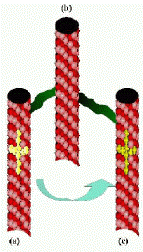
... Schematic of a microtubular quantum teleportation of states.
MT a sends its state (represented by a cross) to MT c without any
transgfer of mass or energy. Both MT a and MT c are entangled with MT b
(entanglement represented by presence of connecting MAPs. ...
... Example of a microtubular logic gate:
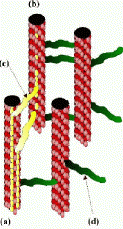
A XOR logic gate where "0" is represented by absence of soliton
and "1" by presence of soliton.(a)Input MT. (b) Output MT. (c)A MAP
transmitting a soliton. (d) A "quiet" MAP. MT a has two solitons
travelling, encountering two MAPs that transmit both solitons to MT b
(b).In this hypothetical scenario, the solitons arrive out of phase at
MT b and cancel each other out. The truth table for XOR reads: 0,0
-> 0;0,1 -> 1;1,0 -> 1,1,1 -> 0. and in this case is
realized by MTs if the MAPs are arranged such that each can transmit a
soliton independently but if they both transmit, the solitons cancel
out. ...".
In a
Tucson
3 paper described on a
cognet.mit.edu web page, Dick
J.
Bierman and Dean Radin say: "... the experimental results
...[in]... experiments ... by Radin ... to explore
physiological indicators of "precognitive information" in which
subjects respond prior to presented stimuli ... suggested a true,
large and replicable "precognitive" psi
effects with a remarkable signal to noise ratio ... DJB ... was
skeptical of these results and therefore decided to replicate the
experiments using the same general procedure ... After 7.05 seconds
... the foreperiod ... Radin originally used a 5
seconds foreperiod. ... a randomly chosen picture, either calm
or highly emotional, is displayed for a specific exposure time ...
Before, during and after exposure the skin conductance is sampled by
the computer with a sampling rate of 5 samples per second ... The
major (and maybe only) source of normal explanations left after
Radin's original studies was the hypothesis that subjects developed
anticipatory strategies ... The major point in favour of the psi
hypothesis is however that there are no indications in the real data
that support any of these sequential strategy models so far. ...
... An interpretation of the exposure times findings is difficult
because there were 3 different times used. It appears that an
exposure time of 600 msec is better than 3000 msec but an exposure
time of 400 msecs is inferior. It should be noted that for 400 msec
exposures the subjects do not always recognize the (emotional)
contents of the pictures. So in that condition they may not always
consciously experience an emotion. ...
... It is said that on the path toward complete control of one's
consciousness at some point psi-phenomena will appear. It is also
said that one should not pay attention to these phenomena because
that would only frustrate progress in meditation performance. Within
this, admittedly very speculative, framework the expected point of
symmetry on the time axis is NOT at stimulus onset but rather at the
start of the conscious (emotional) experience, which may be around
500 msec later. Therefore the peak of the presponse is not expected
around 3.5 seconds before the stimulus onset (where it would be if it
was a mirror image of the response with symmetry point at stimulus
onset) but rather about 2.5 seconds before stimulus onset ...".
In the
paper
itself (revised 12/11/01), Bierman and Radin say: "...
Figure 2 shows the mean response for change in skin conductance for
all calm and emotional trials. ...
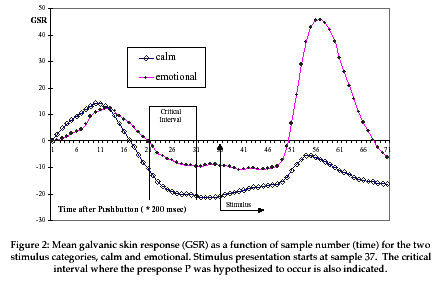
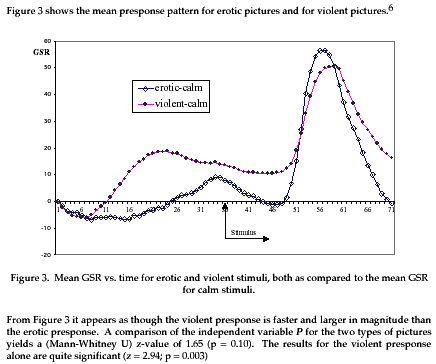
... In Figure 4 the average difference in presponse between
emotional and calm is given for long (3000 msec) and short (400 msec)
exposures. ...
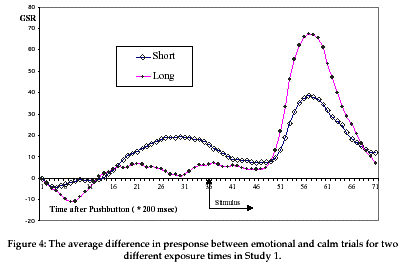
... it is concluded that these data only seem explicable as a form
of "backaction" or retro-causal effect due to conscious experience.
Backaction was discussed in the light of the role of time-symmetry in
physics. It was speculated that consciousness plays the role of a
highly coherent absorber and is therefore responsible for
constructive "backaction" rather than destructive retro-causal
effects which are thought to arise from non-coherent absorbers.
...".
Sometimes I go beyond the Natural Units in which c = G = h
= 1
to use what we used to call in college
SuperNatural Units in which c = G = h = 1 = 2 = pi
(In other words I sometimes ignore factors like
2 and pi, etc., for simplicity.)
Tony Smith's Home Page
......










